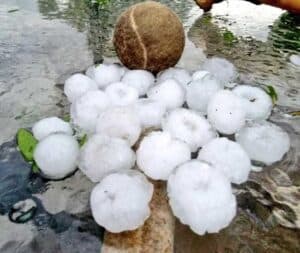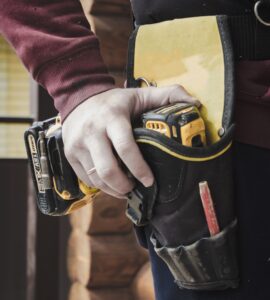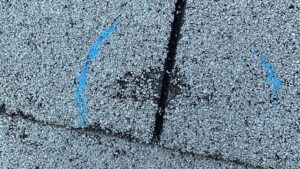On a clear, cool day, hail falling could be a shock. Often occurring during a storm, these small pellets of ice can be an impressive sight. Often in various shapes and sizes, hail can seem harmless. Yet, because it can be as large as baseballs and it is falling from heights, hail can carry a significant amount of impact when it strikes the ground – or any object it strikes.
What Size Hail Will Damage a Roof?
One of the most common types of damage caused by hail is to roofs. As a big, open space, roofs can often be pelted with hail during a storm, creating significant pot marks. Small hail may not seem to do a lot of damage, but when there’s enough of it, it can cause the shingles on your roof to crack, fold, or even fall off.
Should you worry about hail, then? Understanding hail size and its impact can help you determine if there’s a concern to your roof. If you’re not sure, be sure to ask a roofer to provide an inspection for you. They can spot signs of hail damage that could help you to replace your roof (and your insurance company may even cover it).
Hail Size and Roof Damage
Take a look at some of the most common sizes of hail damage. You’ll find that each type can have varying degrees of impact, though, due to the overall force it lands with (depending on where it falls from and the amount of wind behind it).
Pea sized hail
Mild hailstorms create pea sized hail. It measures around ¼ of an inch. Most often, this type of hail occurs for only a few minutes and can even seem as if it is just heavy rain. Most roofs can do well during a hailstorm with small hail like this unless it already has damage or the storm continues for some time. Don’t overlook the risk of damage. If your roof just went through 2 to 5 minutes of pea sized hail damage, it could have some significant impact spots that need repair.
Marble sized hail
At about ½ inch in diameter, marble sized hail may not seem much bigger, but it is far more impactful. It is still likely not to be a problem for most roofs unless they are in poor condition. If you are outside during this type of storm, chances are good it will hurt. It can cause glass to shatter, too, especially if it is thinner. If your roof is older, be sure to inspect it after a hailstorm with marble sized hail.
Dime to quarter-sized hail
Hail that’s larger, such as ¾ to an inch in diameter, tends to have more ability to do damage. This type of hail is more likely to create impact marks on a roof, even a newer asphalt shingled roof. Because it is heavier and falls at such a fast rate, it’s likely to strike the surface of the shingle and either cause the edges to buckle or create holes in it. It is very important to have your home’s roof inspected if you have dime to quarter sized hail, even if it seems to be okay from the ground.
Hail that’s closer to 1 inch in size is most likely to cause significant damage. At this size, it can damage the paint on a car and even crack windows and dent the siding of a home. Take this type of hail seriously.
Golf ball sized hail
Hail can become much larger – even as large as a golf ball. At this size, it’s about 1 ¾ inch or larger, and it has more potential than smaller hail to create substantial damage to your home. Most often, this type of hail will not melt away quickly, and when it strikes the surface of the roof, it may cause significant areas of penetration, potentially even breaking portions off.
Having a roof inspection on hail that is this larger or larger is a must. Though it is less common and typically will only last a few minutes, its potential for causing injury and damage is high. Stay inside, and be sure to inspect any areas struck by the hail after it’s over.
Can hail be even larger? Though larger hail is rare, it is possible for it to reach larger sizes. When that happens, there’s likely less of it, but a big piece of hail that strikes your roof is sure to create damage not just to the shingles but also to the structural material under it.
Unsure How Large the Hail Was?
When you hear hail hitting your rooftop, you may not have any idea what size it is. You may learn the size from the weather station. No matter the size of the hail, it’s beneficial to have a roof inspection after any significant hailstorm. Specifically, have a roof inspector look for signs of damage. This could include holes, pot marks on the shingles, broken tiles, especially if you have a clay tiled roof and areas of wear and tear.
How Do You repair a Roof with Hail Damage?
Depending on the amount of damage to the roof, you may be able to have repairs done. Repairs often involve removing the damaged portions and re-shingling the impacted area. It is typically beneficial to do this if the surrounding roof remains in good overall condition.
If there’s a significant amount of damage, consider replacing your roof. Doing so provides the best level of protection for your home going forward. Often, home insurance policies will cover hail damage like this, covering the cost of replacing your roof as a result.
What to do after hail hits your roof
If you hail damage to your home, or you think you could have a risk of it, be sure to contact a roofing company. Request a quote. Many will provide a hail inspection for you, take photos, and provide you with insight into what you can do moving forward. The good news is this process takes just a few minutes, and you’ll know what to do next right away.





